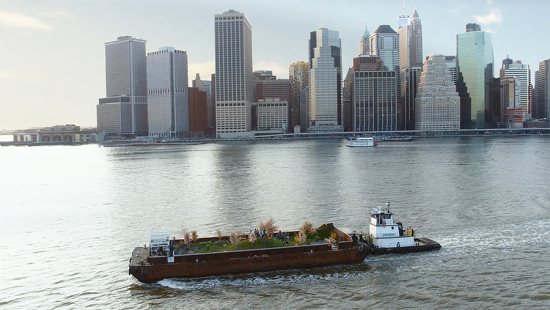Nicole Eisenman: Painting the Story
In a wide-ranging discussion that covered the role of narrative in the artistic process, the frustration of being pigeonholed by labels, and what they are listening to in their studios, Art Professor and Department Chair Paul Ramírez Jonas spoke with Nicole Eisenman in advance of Eisenman's talk at AAP on October 29.
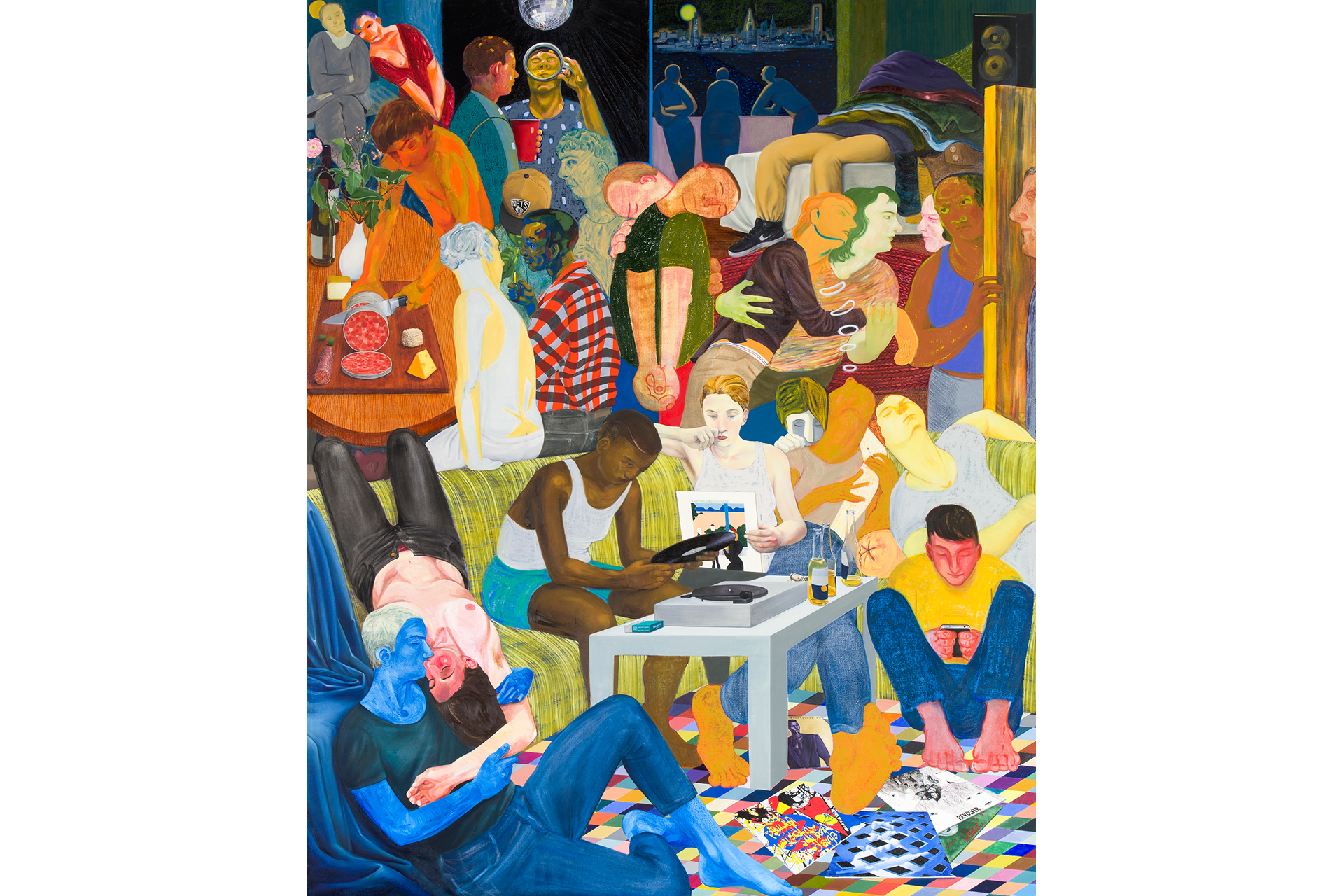
Another Green World (2015), oil on canvas, 128" x 106". image / provided
Nicole Eisenman is an American artist celebrated for their inventive, often irreverent, figurative painting and sculptures. As the fall 2024 guest speaker for the John A. Cooper Visiting Artist Lecture Series at AAP, Eisenman will give a public artist talk on October 29. The series was created with a gift from alumnus John A. Cooper (B.F.A. '97) to bring distinguished artists of particular renown to the Ithaca campus to engage art students and the art community through lectures, studio visits, seminars, and individual critiques with B.F.A. students.
Paul Ramírez Jonas: Even though you have a lot of work featuring a single figure, your narratives are like a party. There are a lot of things happening — maybe not related, but at the same time and in the same place. I think of you as the big storyteller of our time.
Nicole Eisenman: You could leave out the "of our time" part; there are a lot of people who are storytellers. I like the fact that it feels like a party in your head. I like narrative. I come from a tradition of storytellers. My father was an analyst and a biblical scholar. His job was listening and interpreting stories. My grandfather was a rabbi, and that's storytelling, too, so I come from a lineage of storytellers. I studied in Rome for a year, and I was interested in grand scale narrative Italian fresco paintings, more stories.
PRJ: You know, that explains a lot because the first painting I saw of yours was at the Tilton Gallery. Initially I thought, "Oh, is this like a Cezanne, The Bathers?" But no! These bodies were not just little excuses to put paint on the canvas. It felt more like I was looking at a Daumier or a Max Beckmann. Every person was doing something unique.
NE: I think there's a part of my practice where I feel aligned with novelists in the early stages of painting, where I have to sit at my desk and think of stories and construct narratives. It's really the hardest part of my process.
PRJ: I'm always jealous of writers because I feel like being an artist is such a pain in the ass. If you imagine an artwork, you have to make it. If you're a writer, you can create a character and that character is an artist, and then you just describe the work your character made.
NE: It's true. I'm jealous of writers, too. Our culture gives primacy to narrative, to words, and they're just useful in a way that painting is utterly unuseful and in fact, probably clutters the landscape more than anything.
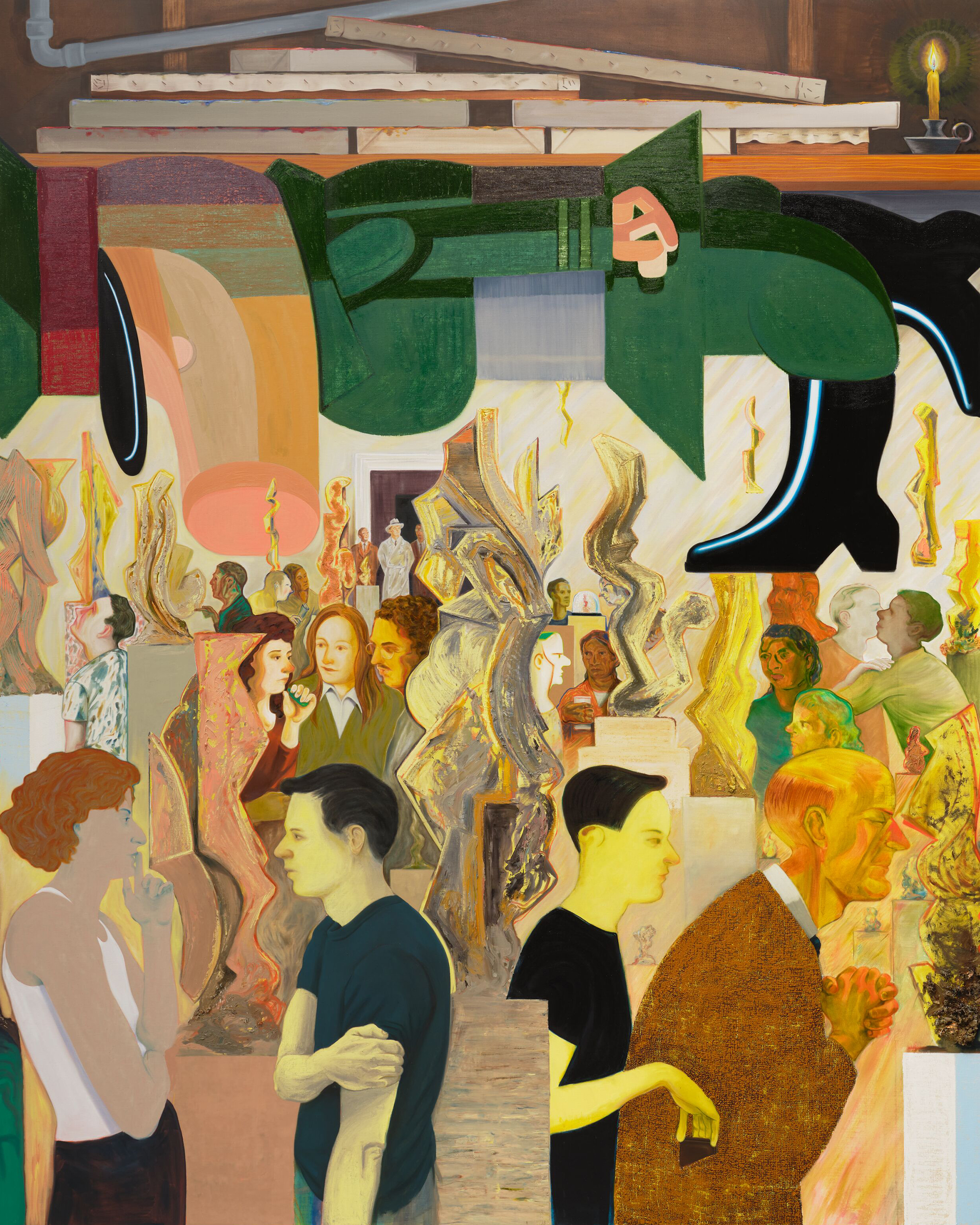
Archangel (The Visitors) (2024), oil on linen, 127" x 105" x 1 1/2". image / provided
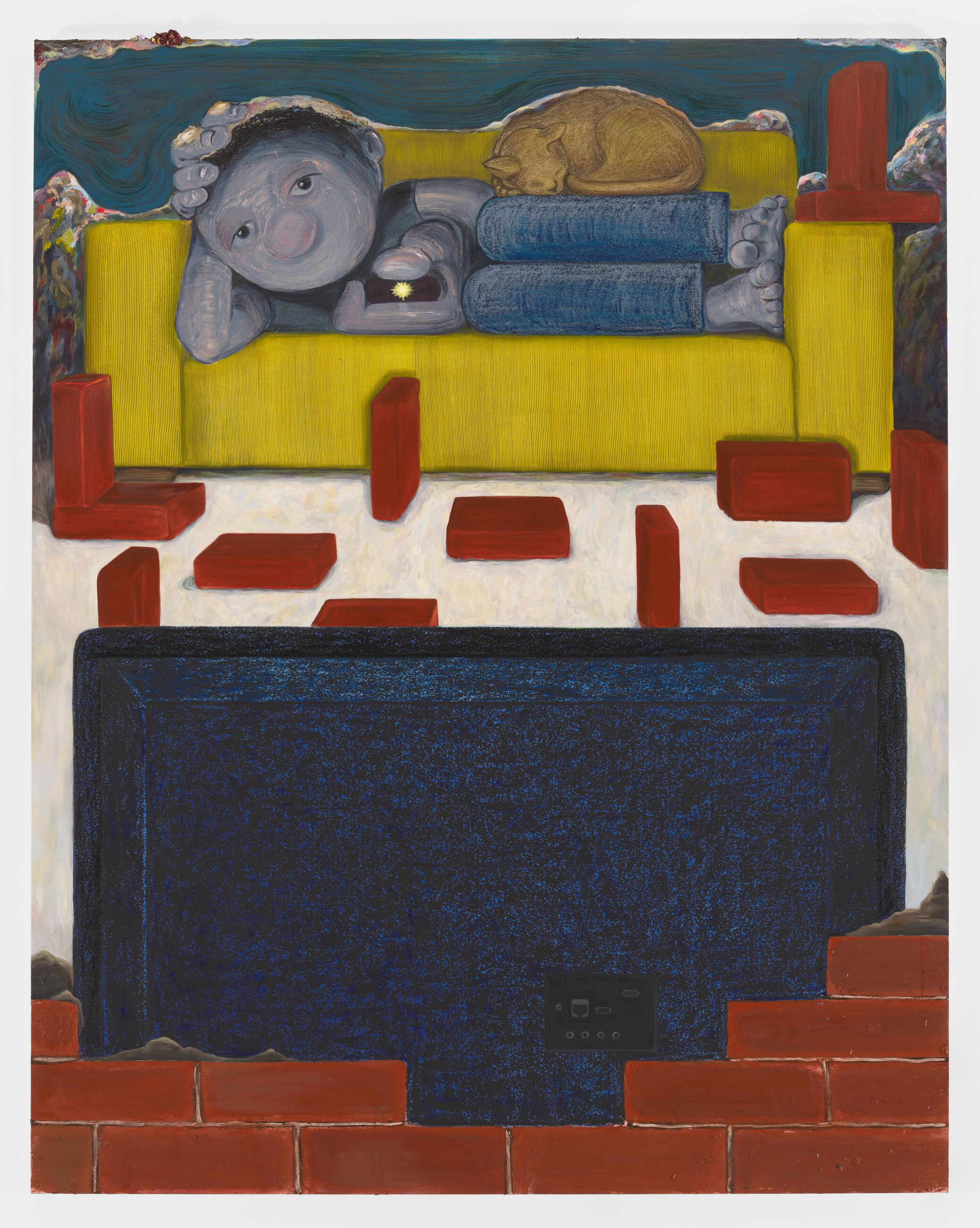
Reality Show (2022), oil on canvas, 82 3/4" x 65". image/provided
PRJ: When you and I were coming into being as artists, everyone was always trying to pigeonhole you. That is part of everyone's career, the world tries to put you in a neat slot, and you didn't get stuck in any of those.
NE: Yeah, my little slot car went careening off the track, and then landed on some other track and then another track. In the '90s, when I started off, I wasn't aware of identity politics. I was really in my head and doing exactly what I wanted to do, and the world did sort of slot me into this "bad girl" slot. I was upset about it because it seemed too limiting. I remember at the time saying I spend more time watching TV than I do thinking about my identity or sleeping with women, but somehow lesbian became my slot, and I did resist it a lot. Finally, toward the end of the '90s, my work that had been so self-reflective started growing away from that. I wanted to take myself out of my work and not have it be so autobiographical. I turned outward.
PRJ: When our studios were next door, I noticed you had a DJ set up in yours, and I did try to copy your DJ setup in my studio and tried it out myself. But the problem was that in my imagination — I don't know what I was thinking! — I thought, "All right, she puts on a track and then she goes and paints." But it's just not enough time. You have to start thinking of the next track as soon as you put on one track. So I would blow two hours DJing and getting nothing done.
NE: Now I have this problem in my studio. I'm collecting records again, and you have to take a break every 20 minutes and flip the record. It's a daily struggle. It's just another chore in the studio, figuring out what to listen to all day. Because it's a long haul. I'll start work as soon as we hang up and I'll finish around seven tonight, and I need either podcasts or music to keep me company.
PRJ: Sometimes I get really difficult books on tape because I know that I will listen to them almost five times, so I don't have to pay attention. It's almost like some Bulgarian Cold War method of learning in your sleep.
NE: I like having a good reader tell me a story as I'm working. And the story gets imprinted in the painting. I have this retrospective that's up in Chicago now, and looking at this very old work I can remember what I was listening to. It gets locked in my brain. I remember listening to a Rachel Kushner book three years ago while I was painting this or an NPR story from 2003 in that painting. I think it goes back to when I was a kid, and I would doodle as I listened to whatever the lesson was in school. It helped me focus. I think it's been proven now scientifically that that is something that can help certain people process language, especially dyslexic people like myself. I doodle all the time, even while we're talking now.
PRJ: Wait, so you made fun of me when I called you the storyteller of our time, and now you're telling me, "I'm listening to the culture, and I'm producing paintings that are directly filtered through it."
NE: The "our time" part seems a little bit too grand, but I'll take the storyteller part.
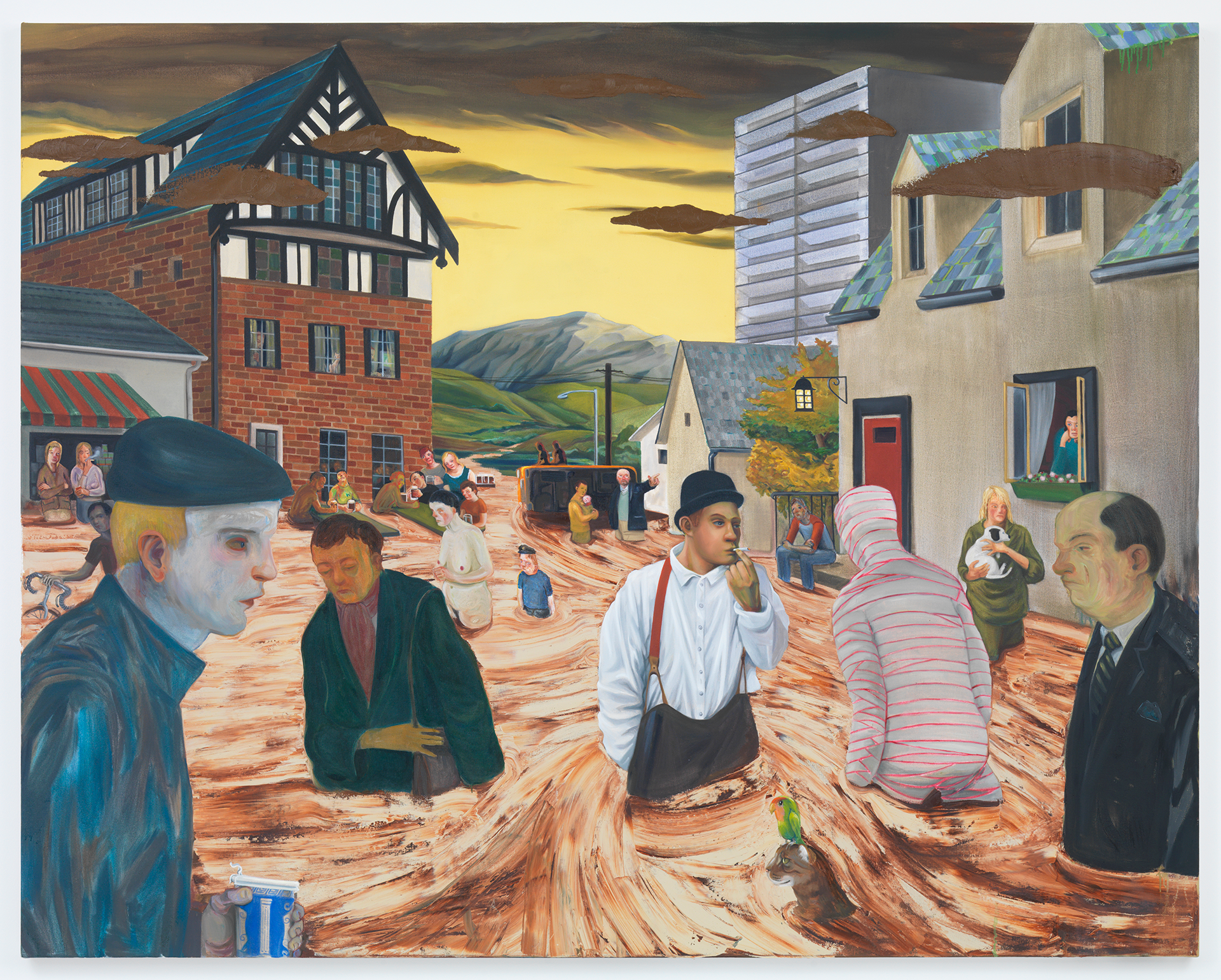
Coping (2008), oil on canvas, 65" x 82". image / provided
PRJ: You're right, it's maybe too grand, but you are grand, right? The stories always feel like history paintings, you know, even when they are not necessarily heroic.
NE: I like playing with scale. I like things that are really large and things that are really small. I like how it makes you feel to be dwarfed by something or to be outsized. Dollhouse furniture, anything that's of a different scale, I enjoy.
PRJ: You're still in the city. You haven't done your exodus to the Hudson Valley.
NE: No. My problem is I don't know if I like the woods or the ocean better. I really like a horizon line. I like big open spaces, and I find it incredibly restorative and grounding to stand next to an ocean.
PRJ: Here, because of the geology, when I go running, there are these vistas that open up and waterfalls and gorges. It's not the ocean, but it's the most Western experience I've had in the East. It's crazy beautiful.
NE: That's a really nice description. It's nice to talk about the land that inspires us.
PRJ: I have a little one and we go for walks and she'll find fossils and all sorts of stuff. Trilobites and stuff like that. I mean, it's not dinosaurs, but you never know.
NE: You never know.
Attend the Lecture and Reception
Nicole Eisenman: Talk Without a Title
John A. Cooper Visiting Artist Lecture Series
Tuesday, October 29 at 5:15 p.m.
Abby and Howard Milstein Auditorium
Milstein Hall




